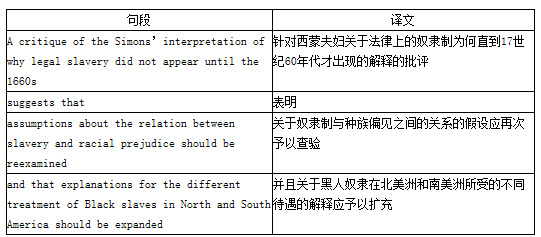The first mention of slavery in the statutes of the English colonies of North America does not occur until after 1660--some forty years after the importation of the first Black people. Lest we think that slavery existed in fact before it did in law, Oscar and Mary Simon assure us that the status of Black people down to the 1660’s was that of servants. (46) A critique of the Simons’ interpretation of why legal slavery did not appear until the 1660’s suggests that assumptions about the relation between slavery and racial prejudice should be reexamined, and that explanations for the different treatment of Black slaves in North and South America should be expanded.
(47) The Simons explain the appearance of legal slavery by contending that, during the 1660’s, the position of White servants was improving relative to that of Black servants. Thus, the Simons argue, Black and White servants, heretofore treated alike, each attained a different status. There are, however, important objections to this argument. First, the Simons cannot adequately demonstrate that the White servant’s position was improving during and after the 1660’s; several acts of the Maryland and Virginia legislatures indicate otherwise. Another flaw in the Simons’ interpretation is their assumption that prior to the establishment of legal slavery there was no discrimination against Black people. It is true that before the 1660’s Black people were rarely called slaves. But this should not overshadow evidence from the 1630’s on that points to racial discrimination without using the term slavery. Such discrimination sometimes stopped short of lifetime servitude or inherited status--the two attributes of true slavery--yet in other cases it included both. (48) The Simons’ argument excludes the real possibility that Black people in the English colonies were never treated as the equals of White people.
This possibility has important ramifications. (49) If from the outset Black people were discriminated against, then legal slavery should be viewed as a reflection and an extension of racial prejudice rather than, as many historians including the Simons have argued, the cause of prejudice. In addition, the existence of discrimination before the advent of legal slavery offers a further explanation for the harsher treatment of Black slaves in North than in South America. (50) Frey and Terry have rightly argued that the lack of certain traditions in North America--such as a Roman conception of slavery and a Roman Catholic emphasis on equality--explains why the treatment of Black slaves was more severe there than in the Spanish and Portuguese colonies of South America. But this cannot be the whole explanation since it is merely negative, based only on a lack of something.
46()
参考答案:
针对西蒙夫妇关于法律上的奴隶制为何直到17世纪60年代才出现的解释的批评表明,关于奴隶制与种族偏见之间关系的假设应再次予以查验,并且关于黑人奴隶在北美洲和南美洲所受的不同待遇的解释应予以扩充。
解析:
[考点解析]

·主句为“A critique suggests that…”,应译为“批评表明……”;且suggests后为并列从句,即“A critique suggests that assumptions should…,and that explanations should…”,可译为“批评表明,假设应……,并且解释应……”。
·of之后的why后的内容可翻译到interpretation之前,即译为“关于……为何……的解释”。
[词汇释义]
·critique批评,评论 ·interpretation解释,理解,翻译
